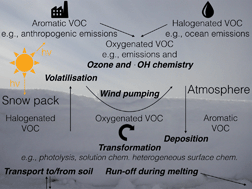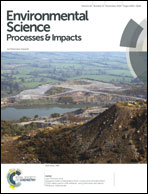Volatile organic compounds in Arctic snow: concentrations and implications for atmospheric processes†
Abstract
The role of volatile organic compounds (VOC) in the snowpack for atmospheric oxidation, gas-particle transfer and aerosol formation remains poorly understood, partly due to a lack of methodology and unavailable data. We deployed solid phase micro-extraction (SPME) gas chromatography with flame ionization detection for measurement of halogenated, aromatic and oxygenated VOC in the snow pack in Alert, NU, Canada, a High Arctic site. Maximum concentrations in snow were 39 ± 6 μg L−1 (styrene), indicating a potential VOC contribution to atmospheric oxidation and aerosol formation. Concurrently sampled air had concentrations of up to 1.0 ± 0.3 ng L−1 (trichloroethene). Back trajectory data showed a change of air mass source region during a depletion event of several VOC in snow (e.g., trichloroethene and benzene). Snow profiles showed an enrichment of most compounds close to the surface. During a second study in Barrow, AK, USA VOC were quantified in snow and frost flowers in the Montreal lab. In Barrow work was carried out as part of the extensive OASIS (Ocean–Atmosphere–Sea Ice–Snowpack) field campaign. Maximum VOC concentrations were up to 1.3 ± 0.1 μg L−1 (acetophenone). Bromoform in frost flowers averaged 0.19 ± 0.04 μg L−1, indicating the potential to contribute to bromine generation through photolysis.



 Please wait while we load your content...
Please wait while we load your content...